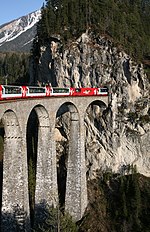Landwasser Viaduct
This article includes a list of general references, but it lacks sufficient corresponding inline citations. (August 2011) |
Landwasser Viaduct Landwasserviadukt | |
|---|---|
 | |
| Coordinates | 46°40′51″N 9°40′33″E / 46.68083°N 9.67583°E |
| Carries | Rhaetian Railway (RhB) |
| Crosses | Landwasser |
| Locale | Schmitten and Filisur, Switzerland |
| Official name | Landwasserviadukt |
| Owner | Rhaetian Railway (RhB) |
| Maintained by | Rhaetian Railway (RhB) |
| Heritage status | UNESCO World Heritage Albula Railway |
| Characteristics | |
| Design | Viaduct |
| Material | Limestone |
| Total length | 136 m (446 ft) |
| Height | 65 m (213 ft) |
| Longest span | 20 m (66 ft) |
| No. of spans | six |
| Piers in water | 0 |
| History | |
| Designer | Alexander Acatos |
| Constructed by | Müller & Zeerleder |
| Construction start | March 1901 |
| Construction end | 1902 |
| Construction cost | CHF 280,000 (1902) |
| Opened | October 1902 |
| Rebuilt | 2009 renovation during full usage (CHF 4.6 Million) |
| Statistics | |
| Daily traffic | 30 passenger trains, few freight trains |
| Location | |
 | |
The Landwasser Viaduct (
Designed by Alexander Acatos, the Landwasser Viaduct was constructed between 1901 and 1902 by Müller & Zeerleder on behalf of the
Location
The Landwasser Viaduct, composed of dark
To passengers on trains approaching the viaduct from Tiefencastel and
Technical details
One of the striking features of the Landwasser Viaduct is its highly pronounced curve, which has a radius of 100 metres (328 ft), the minimum used throughout the whole railway.[3][4] It possesses a height of 65 metres (213 ft) and a length of 142 metres (466 ft).[5] The viaduct's masonry is approximately 9,200 cubic metres (12,000 cu yd) in volume and is jointed with dolomitic limestone.[2] It comprises six arch spans, 20 metres (66 ft) in width, resting on five high pillars; the arches themselves are flat.[6]
The Landwasser Viaduct carries a single railway track, which has a gradient of 2 percent across the structure. The southeastern abutment of the Landwasser Viaduct is located on a high cliff, and at that point, the tracks lead directly into the 216-metre (709 ft) long Landwasser Tunnel.[7] The tunnel's entrance is positioned on a vertical rock wall, having been purposefully aligned with the viaduct.[5] It was considered to be a challenging architectural feat of its era, and its construction employed several innovative techniques.[5][8]
Construction of the Landwasser Viaduct commenced during 1901 and was completed during the following year.[5] Designed by Alexander Acatos for the Rhaetian Railway, its construction was undertaken by Müller & Zeerleder.[8] The viaduct's construction was performed without the use of scaffolding, instead employing two cranes.[5] The limestone pillars were built up around a steel-reinforced core.[8] During 2009, 106 years after its completion, the masonry and track trough of the viaduct were repaired for the very first time.[9][5] To facilitate this renovation, modular scaffolding was temporarily erected around the Landwasser Viaduct.[10]
In popular culture
The Landwasser Viaduct briefly appears as a bridge which was destroyed by
Gallery
-
Approaching from Tiefencastel.
-
Glacier Express panorama cars entering the Landwasser Tunnel.
-
View from the road.
-
View from northeast.
-
With red cover during renovations
See also
- Albula Railway
- Arch bridge
- Bernina Express
- Filisur (Rhaetian Railway station)
- Glacier Express
- Rhaetian Railway
- Schmitten, Graubünden
- Schmittentobel Viaduct
References
Citations
- ^ Graham, Adam H. (19 June 2014). "The Swiss train tourists don't take. National Parks, Switzerland". BBC - Travel. Retrieved 19 June 2014.
- ^ a b "Landwasser Viaduct, Graubünden, Switzerland". Pinlovely.com. 2013. Archived from the original on 4 March 2016. Retrieved 19 June 2014.
- ^ Talbot 2012, p. 303.
- ^ Troyano 2003, pp. 237-238.
- ^ a b c d e f "Rhaetian Railways Landwasser Viaduct". myswitzerland.com. Retrieved 20 April 2020.
- ^ Troyano 2003, p. 238.
- ^ Jowaheer, Roshina (2 January 2020). "Is the Bernina Express the most spectacular railway journey in Europe?". goodhousekeeping.com.
- ^ a b c d "Facts About Landwasser Viaduct". isolatedtraveller.com. Retrieved 20 April 2020.
- ^ "The Glory of Stone". swissinfo.ch. Retrieved 20 April 2020.
- ^ Valerii, Viunov (2011). "Comparison of Scaffolding systems in Finland and Russia" (PDF). Saimaa University of Applied Sciences.
- ^ "Filming Location Matching "Landwasser Viaduct, Filisur, Graubünden, Switzerland" (Sorted by Popularity Ascending)". imdb.com. Retrieved 20 April 2020.
- ^ "Landwasser-Express". Rhaetian Railway. Retrieved 20 April 2020.
- See the references in Landwasserviadukt (de Wikipedia) (in German)
Bibliography
- Talbot, Frederick A. "Railway Wonders of the World." Books on Demand, 2012. ISBN 3-8460-0527-4.
- Troyano, Leonardo Fernández. "Bridge Engineering: A Global Perspective." Thomas Telford, 2003. ISBN 0-7277-3215-3.
External links
 Media related to Landwasserviadukt at Wikimedia Commons
Media related to Landwasserviadukt at Wikimedia Commons- "Landwasserviadukt". brueckenweb.de (in German).
- Landwasser Viaduct at Structurae







